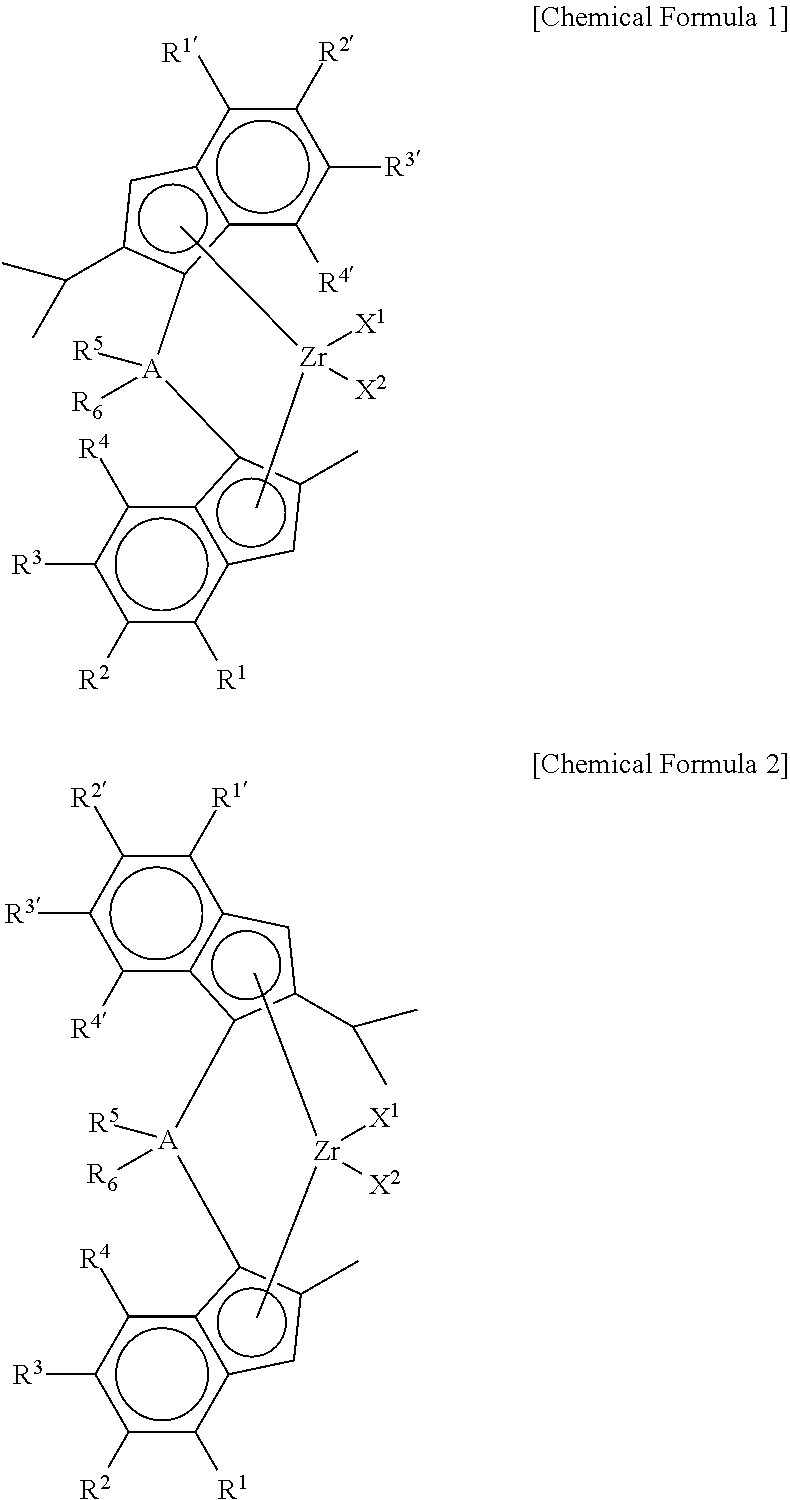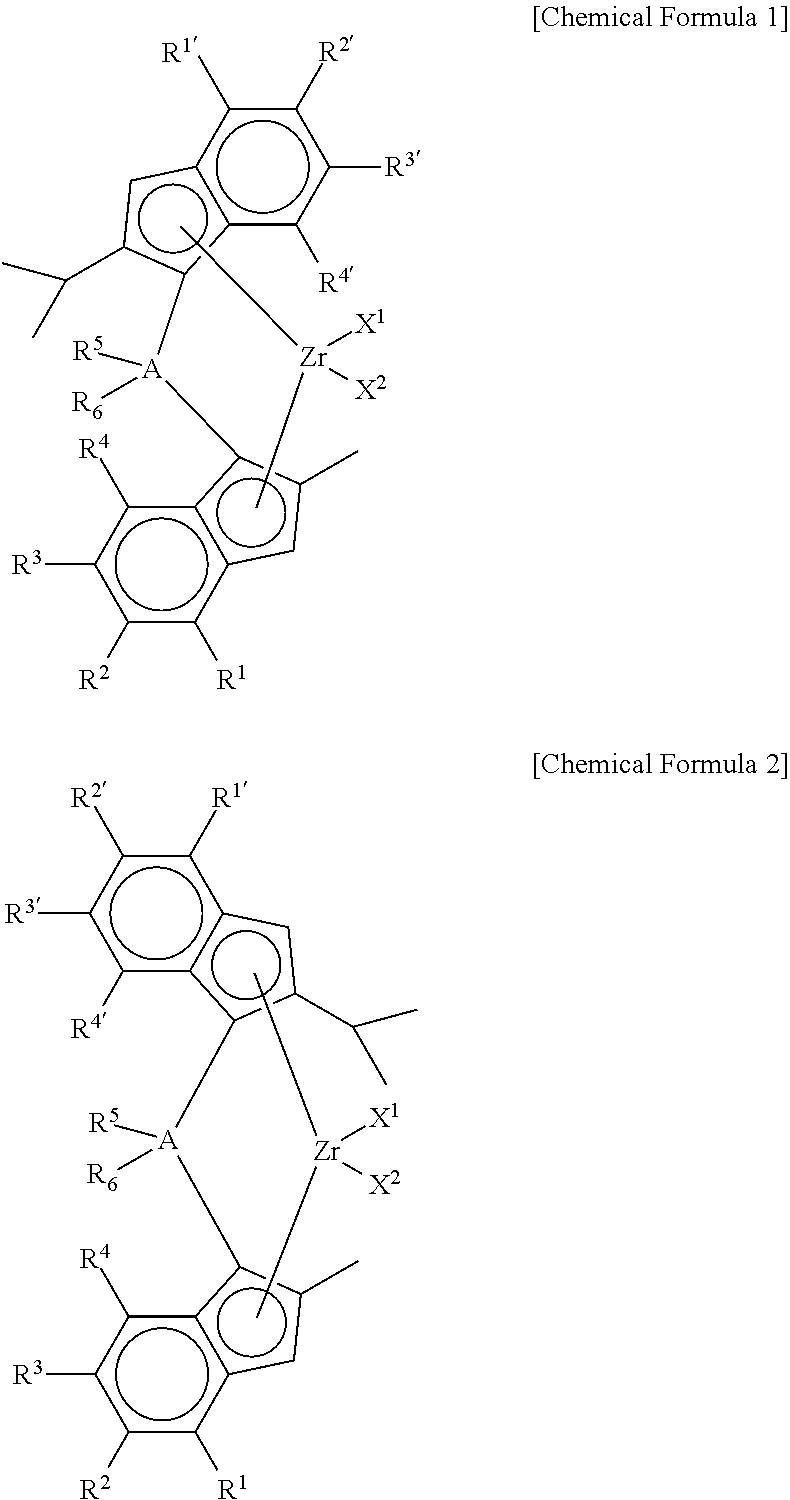Method of Preparing Supported Metallocene Catalyst and Method of Preparing Polypropylene Using Catalyst Prepared Thereby
- Summary
- Abstract
- Description
- Claims
- Application Information
AI Technical Summary
Benefits of technology
Problems solved by technology
Method used
Image
Examples
synthesis example 1
Preparation of (4-(4-(tert-butyl)phenyl)-2-isopropyl-1H-inden-1-yl)dimethyl(2-methyl-4-phenyl-1H-inden-1-yl) silane
[0108]2-iPr-4-tBuPhIndene (1 equiv) was dissolved in toluene / THF (10 / 1, 0.5 M), and then n-BuLi (1.05 eq) was slowly added thereto at −25° C., followed by stirring at room temperature for 3 hr. Thereafter, dichlorodimethyl silane (1.05 eq) was added at −10° C., followed by stirring at room temperature overnight. In another reactor, 2-Me-4-tBuPhIndene (1 eq) was dissolved in toluene / THF (5 / 1, 0.7 M), and then n-BuLi (1.05 eq) was slowly added at −25° C., followed by stirring at room temperature for 3 hr. Thereafter, CuCN (2 mol %) was added, followed by stirring for 30 min. Then, the first reactant mono-Si solution was added, followed by stirring at room temperature overnight. Work-up was performed using water, and then dried to obtain a ligand.
Preparation of dimethylsilanyl-(4-(4-tert-butylphenyl)phenyl)-2-methyl-1H-inden-1-yl)(4-(4-tert-butylphenyl)phenyl)-2-isoproyl-1...
example 1
[0112]0.52 M toluene was added to 10 g of the mixture of Synthesis Example 1, and dissolved at 60° C. for 1 hr. Thereafter, 0.52 M hexane was added thereto, followed by stirring for 30 min. Then, the temperature was decreased to −25° C., and maintained for 72 hr. A supernatant was obtained by decantation, and a filter cake was separated through a filter. The supernatant and filtrate were collected together and vacuum-dried. After completing the solvent drying, a ratio of rac:meso was examined by NMR. Further, a ratio of rac:meso in the filter cake was also examined.
example 2
[0113]0.52 M toluene was added to 10 g of the mixture of Synthesis Example 1, and dissolved at 60° C. for 1 hr. Thereafter, 0.52 M hexane was added thereto, followed by stirring for 30 min. Then, the temperature was decreased to 25° C., and maintained for 72 hr. A supernatant was obtained by decantation, and a filter cake was separated through a filter. The supernatant and filtrate were collected together and vacuum-dried. After completing the solvent drying, a ratio of rac:meso was examined by NMR. Further, a ratio of rac:meso in the filter cake (solid phase) was also examined.
PUM
| Property | Measurement | Unit |
|---|---|---|
| Temperature | aaaaa | aaaaa |
| Temperature | aaaaa | aaaaa |
| Temperature | aaaaa | aaaaa |
Abstract
Description
Claims
Application Information
 Login to View More
Login to View More - R&D
- Intellectual Property
- Life Sciences
- Materials
- Tech Scout
- Unparalleled Data Quality
- Higher Quality Content
- 60% Fewer Hallucinations
Browse by: Latest US Patents, China's latest patents, Technical Efficacy Thesaurus, Application Domain, Technology Topic, Popular Technical Reports.
© 2025 PatSnap. All rights reserved.Legal|Privacy policy|Modern Slavery Act Transparency Statement|Sitemap|About US| Contact US: help@patsnap.com



